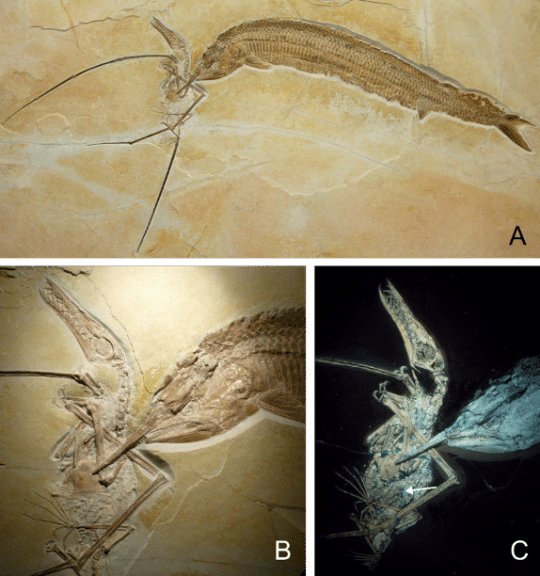As we all seek out responsible ways to enjoy our summer months while the world continues to respond to COVID-19, many of us are embracing the therapeutic effects of the great outdoors. One popular activity, especially in and around the Three Rivers, is fishing. Some modern fishes look positively primeval, as if they were hooked straight out of the Age of Dinosaurs and reeled into the present day. For July’s edition of Mesozoic Monthly, our star is Aspidorhynchus, one of the weird and wonderful fishes that inhabited the oceans of the Mesozoic Era.
Let’s start with a quick lesson on fish, for context. There are two main groups of bony fishes. One group, the class Sarcopterygii, are called the lobe-finned fishes because they have fleshy, limb-like fins that they use to paddle through the water like oars. The first vertebrates to go on land were sarcopterygians, and the descendants of these adventurous fish eventually evolved into amphibians, reptiles, and mammals – including us! Despite their prolific limbed descendants, sarcopterygians make up only a small fraction of fishes today. The vast majority of fish belong to the other class: Actinopterygii, or the ray-finned fishes. These fishes have delicate ray-like bones supporting thinly webbed fins instead of the meaty fins of the sarcopterygians. Actinopterygians are so successful that they dominate both freshwater and saltwater ecosystems, thrive in a variety of habitats, and fill various ecological niches. Such diverse lifestyles mean that actinopterygians come in many shapes and sizes. Nemo (a clownfish) is an actinopterygian. So is the barracuda that ate his mother, the catfish in the Monongahela River, and the unfortunate goldfish you won at the carnival as a kid. Most fossil fishes, like Aspidorhynchus for example, are also actinopterygians.
Aspidorhynchus is an extinct member of the order Holostei, nested, in diagrams of relatedness, within the class Actinopterygii. The only members of the Holostei today are gars and bowfins. Superficially, Aspidorhynchus looks like a gar, but it is more closely related to bowfins. Its name means “shield snout,” in reference to its pointy, swordfish-like upper jaw. Unlike swordfish, which lack teeth as adults, this snout was filled with many sharp teeth. The limited flexibility of its skull restricted its diet to tiny fish, two inches (5 centimeters) in diameter at the largest. Aspidorhynchus was not very large itself, its slender body only growing to approximately two feet (60 centimeters) in length. It was covered with ganoid scales, which are hard, diamond-shaped scales made with a shiny compound called ganoin. Only a few types of modern fishes have ganoid scales, including gar, sturgeon, and paddlefish.

Although species of Aspidorhynchus lived in the Jurassic and Cretaceous periods, we know that it encountered the same struggles as some modern fish due to several remarkable fossils. Just like swordfish, the pointy snout of Aspidorhynchus frequently got it into trouble by impaling other animals! The abundance of fossil evidence for this was provided by the unique conditions of the habitat preserved in the famous Solnhofen Limestone of Germany. In the Late Jurassic, this area was an isolated series of lagoons that accumulated a bottom layer of anoxic brine, which is extra-salty, low-oxygen water where oxygen-dependent (aerobic) life cannot survive. Despite this, the surface still teemed with life: fishes and marine reptiles dominated the water, small non-avian dinosaurs scurried along the shore, and pterosaurs (flying reptiles) and archaic birds flew overhead. The fish-eating pterosaur Rhamphorhynchus seems to have been a fairly frequent victim of the snout of Aspidorhynchus, with multiple fossils documenting unfortunate collisions in which the fish’s snout pierced and became entangled in the wing membrane of the pterosaur. (For a summary of pterosaur wings, check out the March edition of Mesozoic Monthly, on Nemicolopterus.) It’s obvious from the size of the animals that neither was trying to eat the other, but somehow, they became stuck together. As the two animals struggled to survive, they slowly drifted downward into the anoxic brine, where they suffocated and settled onto the bottom of the lagoon. If any other animals had tried to eat or otherwise disturb the corpses, they would have died in the brine as well, so the fossils of the Solnhofen Limestone are typically pristine and undisturbed by scavengers.

Because Aspidorhynchus lived only during the Mesozoic, there’s no chance that a modern-day angler will ever hook one. But should you find yourself fishing in one of Pennsylvania’s rivers or lakes this summer, and manage to land a gar or bowfin, pause for a moment and reflect on the ancient legacy of these fishes – a heritage that dates to the Age of Dinosaurs.
Lindsay Kastroll is a volunteer and paleontology student working in the Section of Vertebrate Paleontology at Carnegie Museum of Natural History. Museum staff, volunteers, and interns are encouraged to blog about their unique experiences and knowledge gained from working at the museum.
Related Content
Preserving Fossil Treasures: Eocene Fishes from Monte Bolca, Italy
Science Chats: Herpetologist Talks About Dinosaurs with Paleontologist
The Bromacker Fossil Project Part VIII: Martensius bromackerensis Honoring a Colleague
